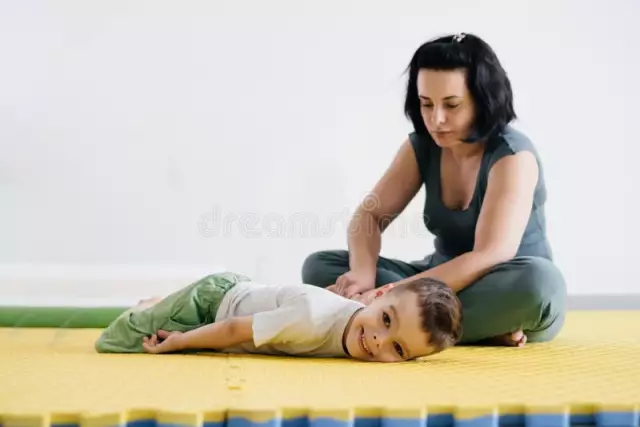- Author Rachel Wainwright [email protected].
- Public 2023-12-15 07:39.
- Last modified 2025-11-02 20:14.
Cerebral palsy
Brief description of the disease

Cerebral palsy or infantile cerebral palsy is a congenital disease of parts of the brain in the process of intrauterine development. Acquired cerebral palsy is extremely rare, due to traumatic brain injury or infection.
Cerebral palsy is the most common cause of childhood disability, affecting nine out of a thousand children.
In many respects, such statistics are explained by insufficient knowledge, complexity and unpredictability of this disease.
Causes of infantile cerebral palsy
The main cause of cerebral palsy is considered to be brain hypoxia. Hypoxia can occur due to rapid or protracted labor, when very small quantities of oxygen enter the baby's brain.
Contact with radiation and chemical substances literally "poisons" the fetus, so it is not surprising that a woman working in hazardous work will give birth to a child diagnosed with cerebral palsy. No less chemical substances, the disease is provoked by X-rays and exposure to electromagnetic fields. The harmful habits of the mother and the pathology of the thyroid gland also have a significant impact on the formation of infantile cerebral palsy in a child.
Trauma sustained during or before childbirth is another factor in the development of cerebral palsy. Injury during childbirth can seriously damage the full-fledged brain of an unborn baby. Most often, in such cases, hemorrhage occurs with the subsequent death of parts of the brain. It is worth noting that children born by cesarean section practically do not have a diagnosis of cerebral palsy.
Infectious diseases such as meningitis or encephalitis can also cause cerebral palsy.
The brain of a newborn can also be paralyzed, intellectually impaired without any birth trauma. It is smaller than the healthy brain of children of this age and is affected by deep genetic disorders. These children, as a rule, rarely survive: there are only 10% of them. In this case, the main cause of the disease is a hereditary factor.
Cerebral palsy symptoms
At an early age, when the child's central nervous system is not fully formed, children with cerebral palsy are almost indistinguishable from others.
Over time, it becomes more noticeable that the baby lags far behind peers in development. He starts to hold his head late and roll over, for a long time he cannot sit without support, does not crawl. The symptoms of cerebral palsy become even more obvious when the child is already a year old, and there are no hints of the first steps. An unhealthy child also has problems with hearing and speech: he does not respond to harsh sounds by blinking, and begins to talk at the age of 2-3. At about the same age, you can see that the child uses mainly one hand (right-handed or left-handed).
The movements of a child diagnosed with cerebral palsy are sharp and uncontrollable or, conversely, sluggish, most often aimless. Cramps of the arms and legs, as well as the lower jaw may begin when crying.
A child aged 5-6 may have a number of uncontrollable habits, such as biting lips, biting nails. He is hyperactive, disobedient. He speaks poorly because he cannot control his lips and tongue. The child begins to salivate due to an inability to control the work of many muscle groups responsible for swallowing. A patient with cerebral palsy develops squint caused by weakness of the muscles responsible for the movement of the eyeball. The gait is most often tense, the child literally walks "on his toes", while the legs are somewhat crossed and pressed against one another.
Cerebral Palsy Treatment

In the best way, physical activity affects the health of a child diagnosed with cerebral palsy, of course, if it is allowed by a doctor. Medical gymnastics classes with specialists, massage, warm baths - this is exactly what is needed for the patient's rehabilitation.
Cerebral palsy treatment involves the use of drugs aimed at improving the functioning of the brain. The Voight method can also be applied, the essence of which is to restore the natural models of human movement, as well as in the formation of motor skills. The child must learn to control balance, to perform grasping and stepping movements of the limbs.
It is also advisable to wear orthopedic shoes, in order to avoid deformation of the foot.
A patient with infantile cerebral palsy should be taught normal walking, regularly and methodically develop each muscle group through training and exercise. Exercises for stretching muscles, for endurance and stress relief will very soon give positive results, and with a long course of treatment, a child diagnosed with cerebral palsy will practically not differ in any way from a healthy peer.
Remember that for a child diagnosed with cerebral palsy, the best treatment is a friendly atmosphere in the family, love and the sincere hope of relatives for recovery.
YouTube video related to the article:
The information is generalized and provided for informational purposes only. At the first sign of illness, see your doctor. Self-medication is hazardous to health!






